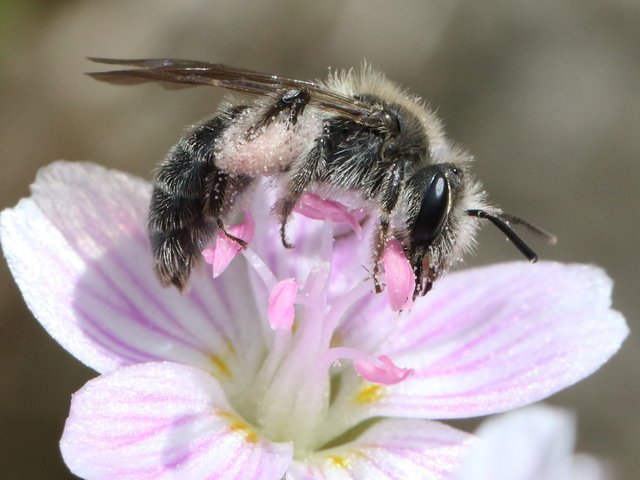Spring Beauty Miner Bee (Andrena erigeniae)
Active Period: March-May
Host plants: Carolina spring beauty (Claytonia caroliniana), Virginia spring beauty (C. virginica)
The Spring Beauty Miner Bee is an oligolege (a term referring to bees that exhibit a narrow, specialized preference for pollen sources) of Spring Beauties. Nesting sites of mining bees such as Andrena erigeniae are usually found in well drained loamy soils with sparse vegetation. Brood chambers are built and provisioned with pollen, the bee deposits a single egg on a pollen cake. Although Spring Beauty Miner Bees only collect pollen from species of Spring Beauty the will visit some other flowers for nectar.
Photo by Michael Veit
Greater Bee Fly (Bombylius major)
Active period: March to May
These flies are among many that imitate bees, and they mimic bumblebees specifically. They have a long, stiff tongue to collect nectar from a variety of flowers including spring beauties (like our Andrena bee species.) They are actually more frequent visitors to these flowers and are just as efficient as bees, so they may actually pollinate more flowers than bees. They are parasitoids of some solitary bees, laying their eggs near nests that hatch, eat the collected pollen plug, and eventually eat the bee larvae inside as well. Despite this, bee-flies do not have a negative impact on solitary bee populations or their other hosts, and parasitism is all part of a healthy ecosystem.
Image courtesy of Beatriz Moisset
Spring Azure (Celastrina ladon)
The spring azure is among the first butterflies of the year. The early spring appearance helps you identify this species. The undersides of the wings are pale gray to whitish, with small dark spots. The upper sides of the wings are usually hard to see, since these butterflies rarely pose with their wings held open, but the upper side of males is iridescent blue, while the upperside of females is blue with a dark border.
Diet: Caterpillars feed on the flowers and fruits of a variety of woody and nonwoody plants, including flowering dogwood, New Jersey tea, blue-eyed Mary, and many more. Adults take nectar from many kinds of flowering plants, including wild plum, early-blooming milkweeds and dogbanes, New Jersey tea, blackberries and their relatives, and other springtime flowers.
Flight: mid-March to May
Habitat: variety of habitats from brushy fields and other open areas to wooded habitats, roadsides, and gardens.
Range: North America from Alaska and Canada south of the tundra, through most of the United States except the Texas coast, southern plain and peninsula Florida; south in the mountains to Colombia.
Photos from wisconsinbutterflies.org





